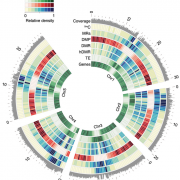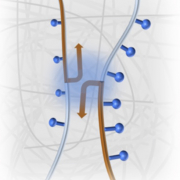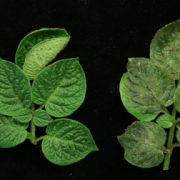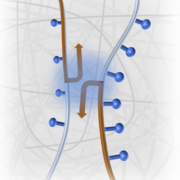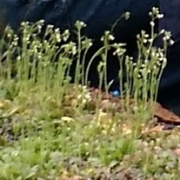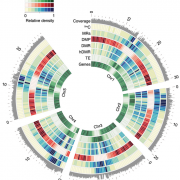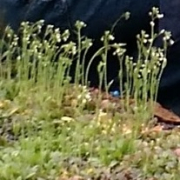Parallel evolution of flowering time in Capsella and Arabidopsis Just out in Genetics
Independent FLC Mutations as Causes of Flowering Time Variation in Arabidopsis thaliana and Capsella rubella.
Guo YL, Todesco M, Hagmann J, Das S, Weigel D.
Capsella rubella is an inbreeding annual forb closely related to Arabidopsis thaliana, a model species
D. Weigel giving plenary lecture at FESPB 2012
Detlef Weigel is delivering today, August 1, a plenary lecture entitled “Arabidopsis thaliana as a model system for the study of evolutionary questions”, at the joint EPSO-FESPB Plant Biology 2012 meeting in Freiburg.
This is what he will discuss:
We … Read the rest
New department members: C. Wang, E. Lim, S. Collani
We were joined in July by three new scientists Physicist Congmao Wang from Shanghai Jiao Tong University joined the Weigel group, and plant biologist Silvio Collani from the University of Padua joined the Schmid group. In addition, informatician Euncheon Lim … Read the rest
eLife website news
Website open for submissions!
See full announcement at http://www.elifesciences.org/call-for-submissions/… Read the rest
A nice post
Lorem ipsum dolor sit amet, consectetuer adipiscing elit. Aenean commodo ligula eget dolor. Aenean massa. Cum sociis natoque penatibus et magnis dis parturient montes, nascetur ridiculus mus. Donec quam felis, ultricies nec, pellentesque eu, pretium quis, sem.
… Read the restNulla consequat massa
eLife website online (Deputy Editor: Detlef Weigel)
eLife is a new high-level journal in the life sciences, supported by the Max Planck Society, Howard Hughes Medical Institute and the Wellcome Trust.
eLife is a researcher-driven initiative for the very best in science and science communication. eLife promotes … Read the rest
No genome needed: synteny- based precision mapping
Mapping-by-sequencing, “SHOREmapping”, is greatly accelerating the identification of causal mutations.
Current whole-genome or transcriptome assemblies from next-generation sequencing data of non-model organisms, however, do not produce chromosome-length scaffolds. We have therefore developed a method that exploits synteny with a related … Read the rest
MiRNA duplex structure controls secondary siRNA formation
Plant secondary siRNA production determined by microRNA-duplex structure.
Out in PNAS by Manavella and colleagues: Plant secondary siRNA production determined by microRNA-duplex structure. In plants, miRNA-mediated cleavage of a target triggers in some cases the production of secondary small interfering … Read the rest
PNAS paper on evolution of epigenetic variants published by Hollister, Smith, Guo, Ott, Weigel & Gaut.
Just out in PNAS: Transposable elements and small RNAs contribute to gene expression divergence between Arabidopsis thaliana and Arabidopsis lyrata, by Hollister, Smith, Guo, Ott, Weigel & Gaut.… Read the rest
New gene silencing method published: MIGS
Virus-induced gene silencing (VIGS) and hairpin RNA interference (hpRNAi), both of which rely on small interfering RNAs, together with artificial microRNAs (amiRNA), are amongst the most popular methods for reduction of gene activity in plants.
However, all three approaches have … Read the rest
Last paper of 2011: Natural variation in A. thaliana miRNAs
Another paper from the Todesco/Balasubramanian duo, in collaboration with the Altmann
Just published online in Current Biology
In this paper, we demonstrate that a naturally occurring polymorphism in the MIR164A gene affects leaf shape and shoot architecture in Arabidopsis thaliana, … Read the rest
Authorative review on natural variation in Arabidopsis thaliana
Just published in Plant Physiology
A Founders Review covering the history of natural variation research in Arabidopsis thaliana, an overview of genetic and genomic tools, current challenges and research directions, and opportunities for future research.… Read the rest
Last paper of 2010 published: non-autonomy of small RNAs
Comparative analysis of non-autonomous effects of tasiRNAs in miRNAs in Arabidopsis thaliana.
By Felippe Felippes, Felix Ott and Detlef Weigel, published online December 5, in Nucleic Acids Research.… Read the rest
Most detailed analysis of recombination landscape in Arabidopsis published
Salomé et al
Now in Heredity by Salomé et al.: The recombination landscape in Arabidopsis thaliana F2 populations Recombination partitions alleles segregating in the progeny of hybrids, and thus has important consequences for the distribution of phenotypic variation … Read the rest
In Nature: Origin of epigenetic variation in A. thaliana
 Last year, we published a paper on DNA mutation rates in A. thaliana, based on the analysis of the genomes of 5 mutation accumulation lines that shared a common ancestor 30 generations ago. We have now determined the methylome of … Read the rest
Last year, we published a paper on DNA mutation rates in A. thaliana, based on the analysis of the genomes of 5 mutation accumulation lines that shared a common ancestor 30 generations ago. We have now determined the methylome of … Read the rest
First major 1001 Genomes paper out in Nature Genetics
We just published its first major phase, based on 80 accessions representing much of the native range of the species.
Finally — after several previous papers in which we developed the tools and vision for the A. thaliana 1001 Genomes … Read the rest
Plant Phys papers on NB-LRR and S-locus evolution out
Two papers by Yalong Guo et al. out in Plant Physiology
On S-locus evolution in A. thaliana and relatives and genome wide comparison of NB-LRR genes in A. thaliana and A. lyrata.… Read the rest
Severe single-locus heterozygous disadvantage in PLoS Genetics
Our latest work on hybrid incompatibility
Out in PLoS Genetics. Our work provides insights into how tandem arrays, which are particularly prone to frequent, complex rearrangements, can produce genetic novelty.… Read the rest
Out in Dev Cell: Impact of NGS on non-model genetics
Developmental Cell is celebrating its 10th anniversary.
Beth Rowan, Detlef Weigel and Dan Koenig are discussing how next-generation sequencing is leveling the playing field for forward genetics in many different species. Read more here.… Read the rest
Whole-genome assemblies of four A. thaliana accessions in PNAS
We have developed a new approach to whole-genome assembly that exploits the high-quality reference genome of Arabidopsis thaliana.
In PNAS, we just published genome assemblies for four strains, including the popular Ler (Landsberg erecta) and C24 strains.… Read the rest

